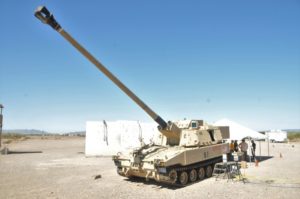The Army on Friday successfully shot two different munitions out of its new extend range cannon for the M109 howitzer reaching ranges of 65 kilometers, with the service readying the second phase of the program within the next few months.
Brig. Gen. John Rafferty, director of the Long Range Precision Fires Cross-Functional Team, told reporters following the test the Army has also made progress on the auto-loader it is developing for the Extended Range Cannon Artillery (ERCA), with plans to test the system in a lab this year and on a howitzer in 2021.

Friday’s ERCA demonstration was conducted at Yuma Proving Ground in Arizona and involved successfully firing the precision-guided munition Excalibur and the XM1113, a rocket-assisted high-explosive projectile, from the XM1299 prototype howitzer’s .58 caliber, 30-foot long gun tube.
BAE Systems is currently on contract with the Army to integrate ERCA upgrades on its howitzers, with 18 of the extended range systems expected to be fielded in 2023 (Defense Daily, July 15).
Army officials have previously said the goal for ERCA is to allow the XM1299, the upgraded version of the M109A7 howitzer, to reach ranges of more than 70 kilometers.
Rafferty said the Army will hold an industry day for ERCA Increment 2 within the next three to to four months to push forward with auto-loader development and further upgrade the system for additional types of projectiles, including potential ramjet capabilities.
The auto-loader, which is still in development at the Armaments Center at Picatinny Arsenal in New Jersey, is expected to allow the howitzer to fire at a rate of six to 10 rounds per minute, according to Rafferty.
“It’ll demonstrate the ability to take the XM1113 of the ready-rack in the howitzer, put in the back of the breach, go grab a super-charge propellant, put that behind it, put the stamp case in there and then allow the crew to fire the howitzer,” Rafferty said. “The other thing that it has to do, which makes it really complex, is it has to fuse it and then set the fuse. Right now, it takes two cannoneers and a sergeant watching them to do that. So it is not a simple machine, but we’ve got world class people working on it right now.”